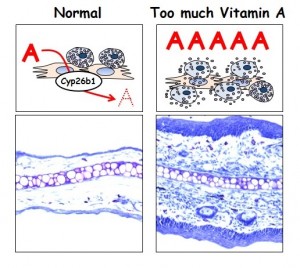You can have too much of a good thing Skin fibroblasts shield mast cells from excess Vitamin A

Mast cells are one of several types of immune cell that are also the cause of allergies and inflammation. It has long been known that mast cells can have different characteristics in connective tissues such as skin and in mucosal tissues such as the intestine and lungs. However, the significance of that difference and the mechanisms by which those characteristics are regulated remained unknown.

© Yosuke Kurashima.
Excess amounts of Vitamin A wakes a sleeping lion in the skin. In the normal state, Cyp26b1 degrades retinoic acid, a metabolite of vitamin A. In the hyper vitamin A condition, activation of mast cells occurs and subsequently dermatitis is observed.
A research group of Assistant Professor Yosuke Kurashima and Professor Hiroshi Kiyono at the University of Tokyo Institute of Medical Science and Project Leader Jun Kunisawa at the National Institute of Biomedical Innovation has confirmed the different characteristics of mast cells in skin, lung, intestinal and other tissues of mice, and revealed that these characteristics are regulated by cells called fibroblasts, which make up connective tissue. The concentration of vitamin A in the skin is regulated by dermal fibroblasts and when there is excessive vitamin A or fibroblasts cease to metabolise of vitamin A, mast cells become abnormally active and induce skin inflammation. In addition, it was found that dermal mast cells expressed less of the receptor to activate mast cells than mast cells in other tissues.
As an example of dermatitis brought about by excessive vitamin A consumption, it is known that the Inuit suffer from skin disorders as a result of eating polar bear liver, which contains large amounts of accumulated vitamin A. This research result provides a pathological mechanism for this skin disorder. This research suggests that the differing characteristics of mast cells in each tissue type and their abnormal activity are connected with chronic inflammation and allergies that occur throughout the body, and offers a new target for development of preventions and treatments.
Press release (Japanese)
Paper
Kurashima Y, Amiya T, Fujisawa K, Shibata N, Suzuki Y, Kogure Y, Hashimoto E, Otsuka A, Kabashima K, Sato S, Sato T, Kubo M, Akira S, Miyake K, Kunisawa J, Kiyono H,
“The enzyme Cyp26b1 mediates inhibition of mast cell activation by fibroblasts to maintain skin-barrier homeostasis”,
Immunity,2014 Apr 17, Vol.40, No.4, p.530-41, doi: 10.1016/j.immuni.2014.01.014.
Article link
Links
Department of Microbiology and Immunology, Institute of Medical Science






